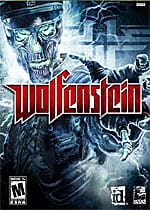Back On Top
Wolfenstein 3D got the FPS genre started on the right foot. Establishing many shooter conventions that would last throughout the 90s, the game has a revered place in the hearts of old-school gamers and developers alike. That first game in the franchise also began the alternate WWII storyline – playing upon Hitler’s strange fascination with the Occult – that has made Wolfenstein an engaging and kooky playground within which gamers can blast away at Nazi scum.
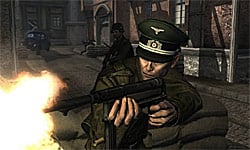
A few reboots and 17 years later, Wolfenstein hits the next-gen shooter scene with slick graphics, smooth controls, an interesting single-player adventure, and a worthy multiplayer offering. Though the game certainly isn’t as legendary as its first entry, it is an enjoyable shooter that anyone remotely interested in the series will appreciate.
The first thing that players will notice is the high production value of the game. From the menu screens to cinematics, the explosions and shootouts to the lighting and animations, Wolfenstein is a very pretty game. I especially liked the natural way characters interacted with each other in conversations both in-engine and during cutscenes. It also helped that the voice acting is of very high quality, though often actor voices are reused a la Fallout 3. Still, the presentation does a great job of setting the stage for the game’s narrative.
In Wolfenstein, you take on the role of B.J. Blazkowicz, an elite agent in the Office of Secret Actions (OSA). After successfully completing a covert mission that destroys the Nazi warship Tirpitz, you’re sent right back in behind enemy lines in order to get to the bottom of the Occult machinations brewing in the sacked city of Isenstadt, Germany. Ostensibly sent as a spy to sabotage and learn about a new Nazi weapon, you quickly find out that something far stranger is afoot. As it turns out, the Nazis are harnessing the power of The Veil and its Black Sun – a parallel dimension full of corruptive energy that will lead the Third Reich to world domination of ghastly proportions if left unchecked. Blazkowicz, the Kreisau Circle resistance, and a clandestine group of scholars known as the Golden Dawn must work together in order to unlock the mysteries of The Veil and put an end to the horrific Nazi plot.
The city of Isenstadt is used as the game’s hub. Players will venture around the city, encountering various power groups and taking on missions against the Nazis. The city setting is a convenient way to advance through the game. It is very condensed which, along with the excellent objective compass and detailed city map, makes getting around very easy. As a result, you’re never left perplexed or slowed down, which makes for an action-packed, high-paced experience. An unfortunate side effect of this is that the city feels artificially small. Rather than being confronted by a massive open-world just waiting to be explored, you’ll really just deal with the same old people and haunts time and again. The only caveat to this being new zones will open up to you upon accepting a mission. However, once the mission is complete, it’s back to the familiar.
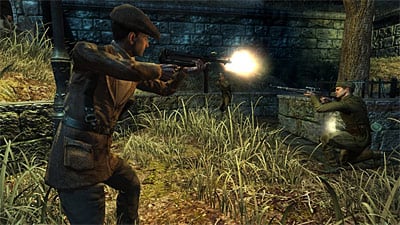
Every mission you accept will help you become a stronger threat. Rather than racking up experience points (Blazkowicz is already the best soldier around), players will have to accumulate monetary rewards, pilfer hidden gold, uncover ancient tomes, and steal key intel in order to unlock upgrades and provide you with the information and funds needed to improve your ability to take out the Nazis. Black market dealers throughout the city will provide you with the means to upgrade your weapons and tap into ever-expanding Veil powers, but it will take a lot of cash to get them to help you. There are only a handful of weapons in the game, and each one has several upgrades that can be installed to increase ammo capacity, silence and reduce muzzle flash, improve accuracy, increase stopping power, etc. While most arms are mundane WWII-era weaponry, some are high-tech, sci-fi cannons – the Particle Cannon that spews out a stream of Veil is particularly lethal. All of these guns, whether standard or fictitious, handle really well and feel right. Moreover, each upgrade actually feels like it does something significant.
Early on, players will acquire supernatural powers via the Veil Medallion. This pendant gives you access to The Veil. While in this parallel dimension, your sight is enhanced, you can shield yourself from enemy attacks, control the passing of time, and imbue ammunition with dark energy. Though your character is certainly a lot tougher while in The Veil, tapping into its powers is limited by the amount of dark energy you can draw from vents scattered throughout the city. As such, switching back and forth between the two dimensions with an eye toward managing your power meter is a constant issue. Luckily, vents are strewn all over, making it a snap to take advantage of the benefits The Veil grants you. Some may see this as less-than-challenging, but I liked being able to tap into the power at will.
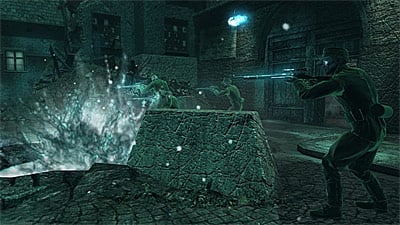
Similar to firearms, the four Veil Powers (Veil Sight, Mire, Veil Shield, and Empower) can also be improved. Veil Sight allows players to see hidden objects and paths, detect enemies through walls, and it increases their speed by transporting them into the alternate reality of The Veil. Mire slows the entire world down around the player like something out of the Prince of Persia trilogy, Veil Shield stops bullets in their tracks and eventually disintegrates enemies with a burst of energy, and Empower imbues ammunition with power from The Veil – making it possible to shoot through enemy Veil Shields and even walls and objects. All of these Veil Powers get more and more powerful by finding tomes and then purchasing the upgrade. When maxed out, these powers are crucial to advancing the plot efficiently.
All in all, completing missions and finding secrets to constantly improve your character is a fun and puzzling metagame that adds variety to the standard shooting elements. It also enhances gameplay by making exploration meaningful. What I wasn’t so fond of was not being able to find enough of the hidden goods to be able to fully upgrade my powers and arsenal. Also, finding the tomes of knowledge should have been enough to open up the Veil Power upgrades. Having to then purchase them through the black market felt out of place and needlessly siphoned funds away from weapon tweaks.
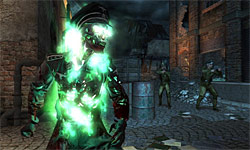
Most of Wolfenstein has players taking out Nazi troopers and looking for hidden objects, but there is also a nice mix of Veil-infused über-enemies that force players to put all their battle skills together. Some of these foes, like Scribes, Assassins, and the Elite Guard, use the power of The Veil to kill you – shielding minions, increasing stealth, and raising corpse. Other toughies like The Altered and Heavy Troopers simply come at you with brute force. Then there are also story-driven boss confrontations that further mix up the combat. I liked the variety of enemies in the game, and the enemy design keeps things interesting. Additionally, the game never left me high and dry in terms of essentials for besting these baddies, or without a clue for how to deal with them. Of course, this did make the game a bit easy on normal difficulty. Fortunately, there are four distinct difficulties to choose from depending on your skill level.
Controls in Wolfenstein are very competent. Icing fools with headshots, lobbing grenades into a crowd of SS, unleashing Veil Powers, smashing the butt of your gun into the back of an officer’s head, and moving around the battlefield all feels tight and intuitive. Even the introduction of zero-G environments and the constant transitions in and out of The Veil are smooth and natural.
The solid controls also help make the multiplayer side of the game worthwhile. Though online multiplayer only supports up to 12 players and has only three modes of play (Team Deathmatch, Stopwatch, and Objective), the eight maps, three classes (Soldier, Engineer, and Medic), and persistent, upgradeable characters/weapons add complexity. However, as intriguing as the multiplayer component is, it’s short-lived. In fact, I had enough of it after just a few sessions. On the other hand, there already is a strong community that seems to be heavily engaged in the online competition, despite the fact it didn’t manage to hook me.
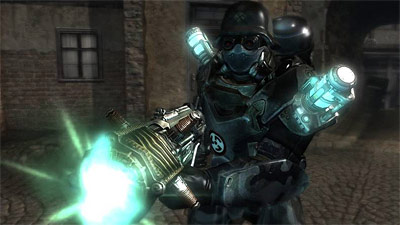
Wolfenstein is a quality title most will enjoy. The solid shooter controls, interesting story, unique Veil mechanics, loads of hidden objects, and fine multiplayer give it legs. It isn’t groundbreaking by any means, but it definitely aims to please.
RATING OUT OF 5 RATING DESCRIPTION 4.5 Graphics
This game looks great from start to finish. There are some rough transitions from zone to zone. 4.5 Control
Butter smooth controls make the shooter experience very satisfying. 4.2 Music / Sound FX / Voice Acting
Background themes heighten the experience, and conversations are accentuated by quality voice work. The limited number of voice actors does hamper the overall aural presentation. 3.6 Play Value
The single-player campaign is a lot of fun, though rather short. Multiplayer and lots of hidden objects help to extend the fun. Still, you’ll be done with the game after a few weeks. 4.0 Overall Rating – Great
Not an average. See Rating legend above for a final score breakdown.
Game Features:
